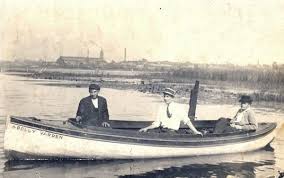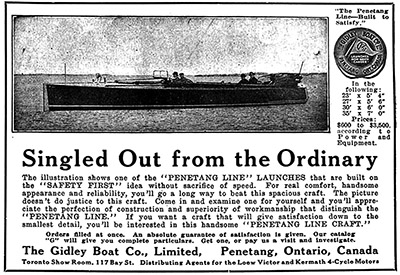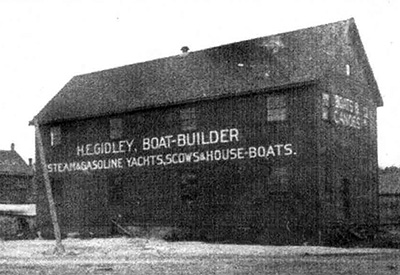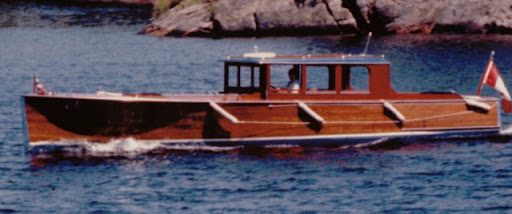

Nov 26, 2025


Nov 19, 2025

Updated: May 16, 2022
By: Richard Crowder

Celebrating Canada's Wooden Pleasure Boat Heritage- Part 3
In Part One of this series we explored the start of wooden pleasure boat building in Canada in the late 1800’s as the availability of leisure time beckoned sportsmen and vacationers to explore the multitude of fresh water found throughout the country. Talented craftsmen fashioned a single boat, sold it to a neighbour or friend or visitor, built another and another until a thriving business was established.
In Part One we covered the creation and demise of one of the most recognized and highly respected and coveted brands, Ditchburn Boats, and then followed that up in Part Two with two brands that evolved out of the demise of Ditchburn – Greavette Boats of Gravenhurst and Hunter Boats of Orillia. In Part Three, we will head west of Muskoka to beautiful Georgian Bay, a massive bay on the northeast arm of Lake Huron in the Great Lakes, to explore a brand you may never have heard of, as well as another recognized brand that may bring fond memories back to many.

Georgian Bay was already a sportsman’s and vacationer’s haven when Henry E. Gidley established his boatbuilding facility in Penetanguishene in the very late 1800’s. He offered an unusually wide range of boats from canoes, rowboats, sailing skiffs, scows, and small powered fishing boats. After the turn of the century, he expanded into motor launches and yachts up to thirty and forty feet, and large unpowered houseboats which were popular at that time. He even built large steam-powered commercial boats.
In the early 1900’s he shared waterfront accommodations in Penetanguishene with the Adams Launch and Engine Company which supplied engines for some of Gidley’s boats. Before the end of 1910, Gidley Boats claimed to be the largest builder of pleasure boats in Canada by utilizing assembly line production techniques.
During this period, Gidley apparently offered not only this wide selection of personal pleasure boats, but also commercial vessels for the Canadian government, the Hudson’s Bay Company, and at least one icebreaker for the Russian government. With immediate access to rail service, Gidley boats could be readily shipped anywhere in North America.
By the 1920’s, Gidley was producing one-off designs of elegant yachts of over one hundred feet. It was during this period that Henry Ford was presented a Gidley launch by one of his personal employees. Ford got in touch with Gidley and arranged, in cooperation with the Ford Motor Company of Canada, to install Ford Model-T engines in a twenty-four foot runabout which became the Gidley-Ford model. It also sported a Model-T windshield, steering wheel, and folding top. It was not particularly successful, even though it appeared for sale in some Ford automobile showrooms.
There is one Gidley boat that stands out above all others, not only for its elegance, but mainly for its famous owner. Following his brother Wilbur’s untimely death, Orville Wright of aviation fame was grief stricken for several years. During this period, he was introduced by a friend to the solitude and natural beauty of Georgian Bay. He loved it, and purchased an island off Honey Harbour as well as a twenty-foot Gidley launch for island access and pleasure boating.












In 1929, Gidley Boats made a custom open top 32-foot Gull Commuter model for a customer to be used as water taxi service out of nearby Parry Sound. However, the Depression resulted in the closure of many businesses, including this one, and the boat was returned to Gidley in Penetanguishene. Orville Wright was ready for a bigger boat and bought it. He had a closed sedan top added to it and eventually helped replace the engine with a 100-horsepower inline 8-cylinder Kermath.
To remain incognito, Orville Wright did not want to name his boat but several close friends including renowned Group of Seven artist A.Y. Jackson collaborated and bought Wright a Christmas present of polished metal letters spelling their chosen name, “KITTY HAWK.” Wright was of course obliged to install this present on his boat, but the installer, thinking it was all one word, installed the letters on the transom as “KITTYHAWK” as it remains to this day.
As a high-profile US citizen that the US Government felt determined to protect during wartime, Orville Wright was called to Washington in 1941 where he eventually died before returning to Georgian Bay. KITTYHAWK has passed through family members, a few owners, and a number of restorations but it remains virtually original. Just recently, KITTYHAWK was listed for sale for an asking price of $495,000. USD and was sold to new owners. During World War II, Gidley Boats also built several of the 112-foot Fairmile anti-submarine patrol boats for the Royal Canadian Navy at its Penetanguishene facility.
Gidley Boats scaled back and survived the Depression years, but just prior to World War II craftsman Arthur Grew who learned his boat building skills in Toronto, along with Toronto financier Clarence Kemp, bought Gidley Boats and merged it with Grew Boats, which at the time was located at Jackson’s Point on Lake Simcoe. The Grew Boat name was transferred to the Penetanguishene operation and continued building boats for many years as one of Canada’s most recognized boat names.
Although Gidley Boats built hundreds of boats of all types and sizes there are relatively few remaining today. Those that have survived in good condition command a high price on the resale market as each one is usually one of a kind.





Fascinating to read about such historical figures enjoying the same cruising areas we visit today! Certainly adds to the experience of exploring beautiful Georgian Bay